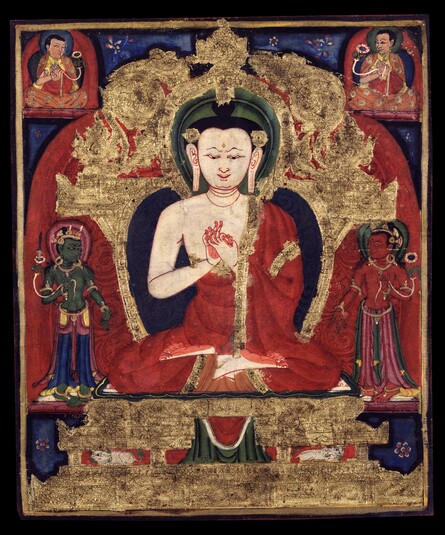
Item: Medicine Buddha - Retinue Buddha
| Origin Location | Western Tibet |
|---|---|
| Date Range | 1300 - 1399 |
| Lineages | Buddhist |
| Size | 25.40x20.32cm (10x8in) |
| Material | Raised Gold on Cotton |
| Collection | Rubin Museum of Art |
| Catalogue # | acc.# F1998.3.6 |
Classification: Deity
One of the Eight Medicine Buddhas. (See HAR #34290).
With one face and two hands, white in colour, he sits in the traditional posture. The hair is piled on the crown of the head forming a topknot (Sanskrit: ushnisha). A dot adorns the forehead (Skt.: urna) and gold flowers decorate the upper tips of the ears with long pierced earlobes below. Three classical beauty lines adorn the neck. The two hands are held to the heart performing the Dharma teaching mudra - loosely resembling an 8-spoked wheel. The left shoulder is covered with a red and gold trimmed robe. The right arm remains bare according to monastic custom. The two legs are folded together in vajra posture with the soles of the feet facing upward - right over left, atop a white snow lion supported throne and elaborate gold backrest. A dark blue nimbus and green areola surround the body and head within a larger circle of red swirling light.
At the left stands a bodhisattva, green in colour, with the right hand placed at the heart holding the stem of a flower blossom supporting an upright sword of wisdom. The left hand extended downward performs the mudra of generosity, wearing jewel ornaments and celestial garments. At the right side a similar bodhisattva, red in colour, performs the mudra of generosity with the right hand and holds the stem of a lotus blossom with the left. At the top corners, right and left, sit monastic figures performing the teaching mudra at the heart and holding the stem of a lotus flower blossoming over the shoulder. They both sit on pink lotus seats surrounded by light.
Jeff Watt 9-99
Buddhist Deity: Medicine Buddha Main Page
Buddhist Deity: Medicine Buddha (retinue figures)
Subject: Strings of Miniature Paintings (Banners)
Collection of Rubin Museum of Art: Painting Gallery 3
Painting Style: Western Tibetan
Buddhist Deity: Vairochana-like Buddha Appearance
Buddhist Deity: Buddha Appearance Page
Shakyamuni Buddha: Iconographic Confusions
Painting Set: Medicine Buddha (Spink/RMA)


